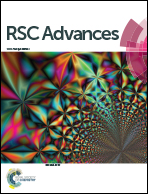Ultra sensitive and wide-range pH sensor based on the BSA-capped Cu nanoclusters fabricated by fast synthesis through the use of hydrogen peroxide additive†
Abstract
The accurate estimation of pH in the environment and on the cellular level is important in environmental, biomedical and bioprocess applications. Herein, we report an ultra-sensitive and wide-range pH sensor based on BSA-capped Cu nanoclusters (CuNCs), fabricated using a fast synthesis method through the use of hydrogen peroxide as an additive. Owing to its strong oxidation capacity, hydrogen peroxide partially destroys the peptide and disulfide bonds in the BSA molecule and results in an increased exposure of hydrophilic groups capable of protonation, which greatly accelerate the formation of CuNCs and improve the response of the CuNCs towards pH fluctuation in the surrounding environment. The results demonstrate that the decrease in repulsion and conformational change of BSA with decreasing pH values induce the aggregation of CuNCs, leading to a color change and fluorescence quenching of the CuNCs at low pH values. The fluorescence intensity exhibits a linear relationship over the pH range of 2–14 and increases by around 20-fold with greater fluorescence at higher pH values. The sensitivity and pH range are much better than those of other metal nanocluster pH sensors reported in the literature. The pH probe is also sensitive to different buffer solutions, except for those containing ions that could react with the CuNCs. The ionic strength of the buffers has little influence on the pH-responsive behaviour. The proposed pH sensor has been successfully applied for measuring the pH value of natural water and the intracellular pH of RBL-2H3 cells. The study also provides a promising candidate for application in biological, medical and pharmaceutical fields.


 Please wait while we load your content...
Please wait while we load your content...